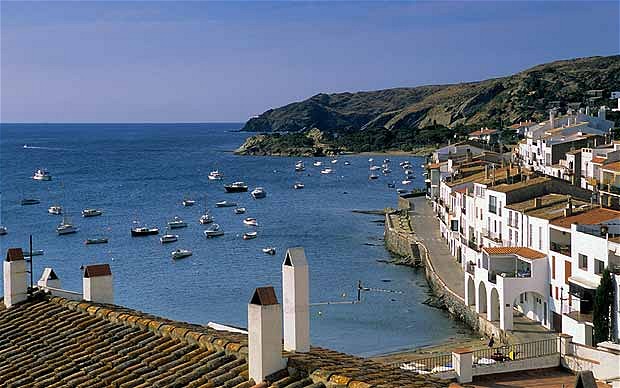Cadaqués (Catalan pronunciation: [kəðəˈkes]) is a town in the Alt Empordà comarca, in the province of Girona, Catalonia, Spain. It is on a bay in the middle of the Cap de Creus peninsula, near Cap de Creus cape, on the Costa Brava of the Mediterranean. It is only a two-and-a-quarter hour drive from Barcelona,
and thus it is very accessible and not only attracts tourists but
people who want a second home for weekends and summers. In 2002,
Cadaqués had an official population of 2,612, but up to ten times as
many people can live in the town during the peak of the summer tourism
season.
Cadaqués has a special place in art history. Commanding charcoals, by local artist Mei Fren, of the 19th century Cadaqués beleaguered by a winter tramontane,
can be seen at the Cadaqués museum. Fren was the first modern artist to
live in Cadaqués and gave the town many of his works and a marble top
table on which he sketched many of its turn-of-the-century fishermen.
Salvador Dalí often visited Cadaqués in his childhood, and later kept a home in Port Lligat, a small village on a bay next to the town. A summer holiday here in 1916, spent with the family of Ramon Pichot is seen as especially important to Dalí's artistic career. Other notable artists, including Pablo Picasso, Joan Miró, Marcel Duchamp, Richard Hamilton, Albert Ràfols-Casamada, Antoni Pitxot, Henri-François Rey, Melina Mercouri and Maurice Boitel also spent time here. Cadaqués is mentioned in the story "Tramontana" by Gabriel García Márquez
The interesting submarine life of this sleepy fishing village was studied for several years by phycologist Françoise Ardré, long before Cadaqués was discovered and transformed into a tourism
destination. On Mondays there is a travelling market in Cadaqués,
located near the parking lot. This market has a wide variety of
products.
In the early 20th century a large number of inhabitants of Cadaqués travelled or emigrated to Cuba
(the figure has been estimated as one third of a village of
approximately 1200 people). Many of these immigrants were financially
successful in Cuba and returned to Cadaqués where they constructed large
and ornate houses. These houses can still be seen in the town (for
example; the "Casa Blava", "Blue House" in English). A person returned
from Cuba was referred to as an "Americano" among other names.
The village of Cadaqués has its own variant or dialect of the Catalan language.
One of the most notable features is that the definite articles are
different from standard Catalan, namely, they are "sa" (feminine) and
"es" masculine instead of the normal Catalan definite articles "la" and
"el". This feature is shared with the variant of Catalan spoken in the Balearic Islands. The explanation for this (see "El Vocabulari de Cadaqués", Ernesta Sala i Bruses) is that when the Catalan ruler Jaume I
conquered the Balearic Islands in the Middle Ages he re-colonized the
islands with people from the Empordà region of Catalonia. Because
Cadaqués has remained relatively isolated from the surrounding region
(owing to its geography), the mediaeval speech patterns have been
preserved.
Origin Wikipedia..


















Post a Comment